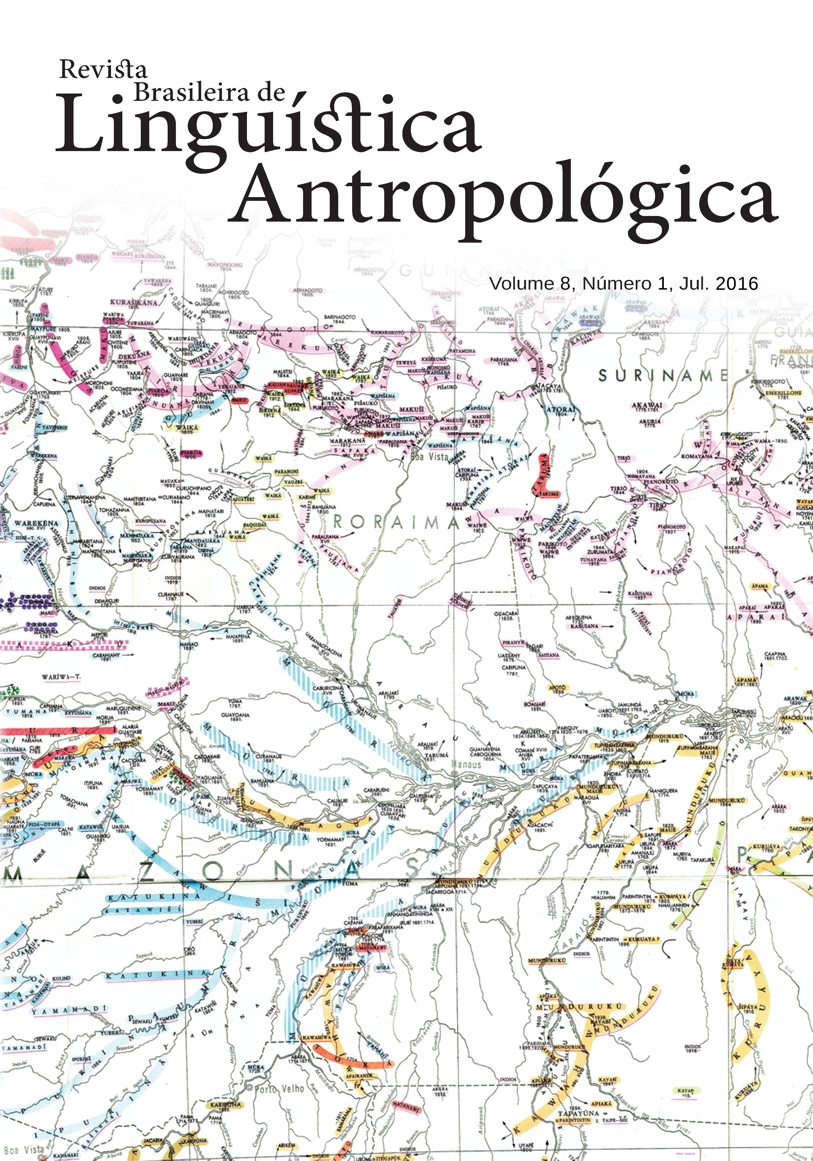A Noção de Tempo: uma construção social e linguística
DOI:
https://doi.org/10.26512/rbla.v8i1.16310Keywords:
LinguísticaAbstract
Neste trabalho, contestamos a Hipótese do Mapeamento Universal com base em pesquisa realizada com uma língua Tupi-Kawahib, da Amazônia brasileira: a língua amondawa. Salientamos, entretanto, que não contestamos a hipotética universalidade dos fundamentos cognitivos do mapeamento linguístico espaçotempo.
Downloads
References
Boom, Paul. 1996. Intention, history, and artifact concepts. Cognition 60, 1-29. Clark, Herbert H. 1973. Space, time, semantics and the child. In: Moore, T. E. (Ed.), Cognitive development and the acquisition of language, 27-63. New York: Academic Press.
Dehaene, Stanislas; Izard, Véronique; Spelke, Elizabeth & Pica, Pierre. 2008. Log or linear? Distinct intuitions of the number scale in Western and Amazonian indigene cultures. Science 320, 1217-1220.
Evan, Vyvyan. 2004. The structure of time: Language, meaning and temporal cognition. Amsterdam: John Benjamins.
Evans-Pritchard, Edward E. 1939. Nuer time-reckoning. Africa: Journal of the International African Institute 12 (2),189-216.
Evans-Pritchard, Edward E. 1940. Nuer. Oxford: Oxford University Press.
Fauconnier, Gilles and Turner, Mark. 2008. Rethinking metaphor. In. Ray Gibbs (ed.) The Cambridge handbook of metaphor and thought, 53-66. Cambridge: Cambridge University Press.
González, Hebe Alicia. 2005. A Grammar of Tapiete (Tupi-Guarani). Pittsburgh, PA: University of Pittsburgh PhD thesis.
Grady, Joseph. 1999. A typology of motivation for conceptual metaphor: Correlation vs. resemblance. In: Ray Gibbs & Gerard Steen (eds.), Metaphor in cognitive linguistics, 175-204. Amsterdam: John Benjamins.
Haspelmath, Martin. 1997. From Space to time: Temporal adverbials in the world’s languages (Lincom Studies in Theoretical Linguistics 3). Munich: Lincom Europa.
Hutchins, Edwin. 2005. Material anchors for conceptual blends. Journal of Pragmatics 37, 1555-1577.
Keyes, Charles F. 1975. Buddhist pilgrimage centers and the twelve-year cycle: Northern Thai moral orders in space and time. History of Religions, 15 (1), 71-89.
Lakoff, George, and Johnson, Mark. 1980. Metaphors we live by. Chicago: University of Chicago Press.
Lakoff, George, and Johnson, Mark. 1999. Philosophy in the flesh: The embodied mind and its challenge to Western thought. New York: Basic Books.
Langacker, Ronald W. 1987. Foundations of cognitive grammar. Vol. 1. Theoretical prerequisites. Stanford, CA: Stanford University Press.
Leite, Yonne de Freitas. 2000. A Gramática de Anchieta. Ciência Hoje, 28 (163), 43-47.
Moore, Kevin. 2006. Space-to-time mappings and temporal concepts. Cognitive Linguistics 17,199-244.
Muysken, Pieter. 2008. Nominal tense. Time for further Whorfian adventures? Commentary on Casasanto. Language Learning 58: Suppl. 1, 81-88.
Núñez, Rafael and Sweetser, Eve. 2006. With the future behind them: convergent evidence from Aymara language and gesture in the crosslinguistic comparison of spatial construals of time. Cognitive Science 30, 1-49.
Pérez, Aveline. 1990. Time in motion: Grammaticalization of the be going to construction in English. La Trobe University Working Papers in Linguistics 3, 49”“ 64.
Pica, Pierre; Lemer, Cathy; Izard, Véronique, and Dehaene, Stanislas. 2004. Exact and approximate arithmetic in an Amazonian indigene group. Science 306, 499-503.
Sinha, Chris. 1988. Language and representation: A socio-naturalistic approach to human development. Hemel Hempstead: Harvester-Wheatsheaf.
Sinha, Chris and Jensen de López, Kristine. 2000. Language, culture and the embodiment of spatial cognition. Cognitive Linguistics 11, 17-41.
Talmy, Leonard. 1983. How language structures space. In: Herbert L. Pick, Jr. and Linda P. Acredolo (Eds.). Spatial orientation: Theory, research and application, 225- 282. New York: Plenum Press.
Talmy, Leonard. 1985. Lexicalization patterns: semantic structure in lexical forms. In: T. Shopen (ed.), Language typology and syntactic description. Vol. 3, Grammatical categories and the lexicon, 36-149. Cambridge: Cambridge University Press.
Talmy, Leonard. 1991. Path to realization: a typology of event conflation. Proceedings of the 17th Annual Meeting of the Berkeley Linguistics Society, 480-520. Berkeley, UC Berkeley.
Talmy, Leonard. 1999. Fictive motion in language and “ception”. In. P. Bloom, M. Peterson, L. Nadel & M. Garrett (eds.), Language and Space, 211-276. Cambridge, MA: MIT Press.
Tomasello, Michael. 1999. The cultural origins of human cognition. Cambridge, MA: Harvard University Press.
Yu, Ning. 1998. The contemporary theory of metaphor: A perspective from Chinese. Amsterdam: John Benjamins.
Zinken, Jörg; Sampaio, Wany; da Silva Sinha, Vera & Sinha, Chris. 2005. Space, motion and time in Amondawa: Field manual 2005-6. Portsmouth: University of Portsmouth.
Downloads
Published
How to Cite
Issue
Section
License
Copyright (c) 2017 Revista Brasileira de Linguística Antropológica

This work is licensed under a Creative Commons Attribution 4.0 International License.
Authors who publish in RBLA agree to the following terms:
a) Authors maintain the copyright and grant the journal the right of first publication, and the work is simultaneously licensed under the Creative Commons Attribution License, which allows the sharing of the work with recognition of the authorship of the work and initial publication in this journal.
b) Authors are authorized to assume additional contracts separately, for non-exclusive distribution of the version of the work published in this journal (eg, publish in an institutional repository or as a book chapter), with recognition of authorship and initial publication in this journal.
c) Authors are allowed and encouraged to publish their work online (eg, in institutional repositories or on their personal page) at any point before or during the editorial process, as this can generate productive changes, as well as increase impact and citation of the published work.







